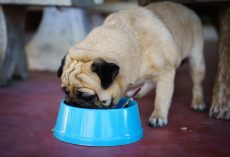The distinguished Dr. Justine Lee has compiled a list of the most common indoor and outdoor plants, those which are poisonous to dogs and cats! Here are five and you will want to watch your animals very carefully if they come into contact with them!
Two Outdoor Plants:
Blue-green algae
Blue-green algae poisoning is fortunately rare, but just a tiny amount (a few) can be fatal. Blue-green algae, or cyanobacteria, grow on top of freshwater or brackish bodies of water. Typically, the algae blossoms during warm, humid weather.The toxins found in cyanobacteria can cause severe liver failure and neurologic signs and can cause death within a matter of hours. Keep your pet away from any water with algae floating on it, because it’s impossible to know if it’s the deadly kind without laboratory analysis.
Sadly, even with aggressive treatment including IV fluids, blood transfusions and appropriate medications, the prognosis is poor for pets who consume blue-green algae.
Lilies
Lilies from the lilium and hemerocallis species (called “true” lilies) are deadly to kitties. These include the Easter, tiger, Japanese show, stargazer, rubrum and day lily.Just two to three leaves or petals, or even the pollen or water from a vase holding the lilies, can result in severe acute kidney failure and death.
Signs of poisoning include vomiting, lack of appetite, abnormal urination, lethargy and progressive kidney damage.
With immediate treatment, especially aggressive decontamination and IV fluids, the vast majority of cats can survive this type of poisoning.
Three Indoor Plants:
Plants from the Araceae family
These include the philodendron, pothos, peace lily, calla lily, dumb cane, arrowhead vine, mother-in-law’s tongue, sweetheart vine, devil’s ivy, umbrella plant and elephant ear.These are common houseplants and contain insoluble calcium oxalate crystals. If your pet chews on one of them, it can cause severe mouth pain. Signs your dog or cat may have sampled one of these plants include drooling, pawing at the mouth, a swollen muzzle or lips and occasionally, vomiting.
Fortunately, these plants aren’t considered deadly, so if your pet chews one, give him some milk or yogurt to minimize damage from the calcium oxalate crystals.
Corn plant/dragon tree
Corn plants contain saponins, which are anti-nutrients that interfere with absorption of essential nutrients. If your pet should sample a corn plant, it can cause dilated pupils, drooling, vomiting, diarrhea and lethargy. This is a much more benign type of poisoning than some others, but you’ll still want to keep this plant out of your dog’s or cat’s reach.Spring flowers
Certain spring bulbs, including daffodils, hyacinth and tulips, can cause mild vomiting or diarrhea in pets who ingest them. If a massive amount of bulbs are eaten, they can actually cause an obstruction in your pet’s stomach or intestines.
Keeping our pets well begins with identifying these and the other plants over on Healthy Pets. They are toxic and can do some terrible things to our pet’s liver and other vital internal organs!
Even if you merely suspect your dog has eaten poisonous plants it is really important that you check symptoms and call the Pet Poison Helpline at 855-764-7661. You can also call your dog’s veterinarian or the ASPCA’s poison control unit at 888-426-4435.









